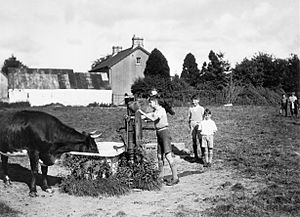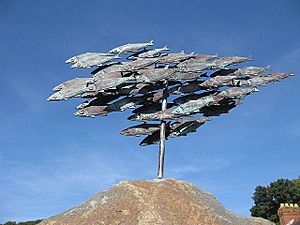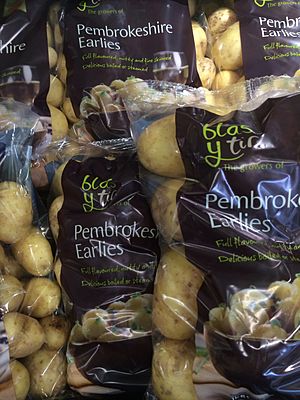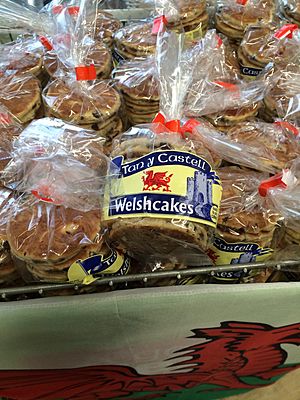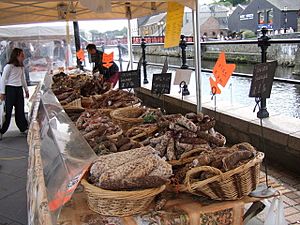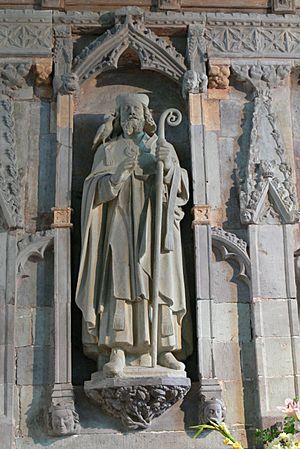Cuisine of Pembrokeshire facts for kids
Pembrokeshire is often called "the cottage garden of Wales." This is because it has great soil and a mild climate. The Gulf Stream helps keep the weather warm, so plants can grow for a longer time here than in other parts of Wales.
This good climate and soil made the south of the peninsula very attractive. People like the Norsemen and Normans wanted this land. It was known for having "great plenty" of corn and cattle.
Most of Pembrokeshire's best farmland is about 70 meters above sea level. To the north, you'll find the Preseli Hills. These hills are higher, reaching 500 meters. They are covered in heather and bracken, which are perfect for sheep to graze on.
Pembrokeshire is one of the most fertile areas in Wales. About 14% of its farmland is top quality. Another 67% is medium quality, and 19% is poor quality. Farming can be tough sometimes. In the 1890s, there was a big farming slowdown. Many fields were left unplanted. Farmers and workers had to move to the New World to find work. Many large farms were sold.
Things got better during World War I. But in the 1930s, there were more tough times for farming. This lasted until World War II. After the war, new plans helped farmers sell and distribute their produce. This made farming in Pembrokeshire successful again.
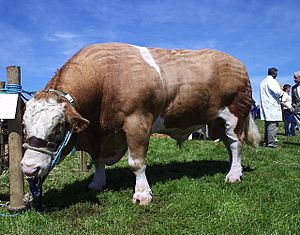
Today, Pembrokeshire is famous for its amazing food. It uses its high-quality farm products well. Gilli Davies says that Fishguard is a top spot for food lovers. St Davids has become known for its great food shops. Milford Haven is also popular for its local foods and special deli items.
Contents
- Meat and Poultry from Pembrokeshire
- Fish from Pembrokeshire Waters
- Fruit and Vegetables from Pembrokeshire Farms
- Milk, Cheese, and Ice Cream
- Bread and Cakes
- Preserves and Delicatessens
- Drinks from Pembrokeshire
- Farmers' Markets in Pembrokeshire
- Food Festivals in Pembrokeshire
- Pembrokeshire Produce Mark
- Pembrokeshire Recipes
- Traditions with St David
- Images for kids
Meat and Poultry from Pembrokeshire
The Pembrokeshire coast has tall cliffs, big bays, and small coves. Behind them are rolling fields. These fields are excellent for dairy farming. The middle of the county has the River Teifi and its valley. This area is full of dairy and mixed farms.
Most farms here raise sheep. Larger farms in the south prefer breeds like Clun Forest sheep, Suffolk sheep, and Cheviot sheep. In the north, farms in the Preseli Hills have Welsh Mountain sheep.
Pembrokeshire also produces beef. A special local breed is the Welsh Black cattle. This breed partly comes from an old, extinct breed called Pembroke cattle. Gilli Davies notes that Welsh Black cattle in Pembrokeshire grow very large. They also produce a lot of milk. This is thanks to the county's rich pastures.
Because of this, Welsh Black cattle from Pembrokeshire were seen as a special type. The Welsh Black cattle from Castlemartin, Pembrokeshire even have their own herd book. In the 1800s, there were two types: a smaller one from North Wales and a bigger one from Castlemartin.
Later, the Welsh Black cattle became less popular. This was because of their long horns. Also, farms started to focus on just beef or just milk. So, other breeds like Hereford (cattle) for beef and Friesian cattle for milk became common. But now, the Welsh Black breed is popular again. You can find its meat in shops and farm stores across the county.
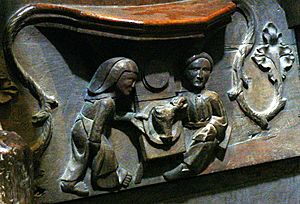
Colin Pressdee says Pembrokeshire is also known for its poultry. The Pembrokeshire turkey is as famous as the Aylesbury duck. Geese were also common. The county was once known for its "Michaelmas Geese," also called "Green Geese." These birds were found on almost every farm and village green. Today, poultry, including hens and turkeys, are still an important part of farming. This is especially true for medium and smaller farms.
Fish from Pembrokeshire Waters
Pembrokeshire's coast has many wild fish. Small fishing fleets traditionally work from Fishguard, St Davids, Solva, Tenby, and Milford Haven. Larger fishing trawlers operate from Milford Haven. Lord Nelson once called Milford Haven "one of the greatest natural harbours in the world."
In 1890, over 1,600 fishing boats used Milford Haven's docks. It became one of Britain's busiest fishing ports. After World War II, it became less busy. But in 1950, its trawlers still caught a good amount of the UK's fish. They mainly caught European hake.
Today, Milford Haven is a base for foreign trawlers. Most of their catch is sent to other countries in Europe. These boats bring money to Milford Haven. They catch hake off the west and southwest coasts of Ireland. Herring are also caught when they are in season.
Expensive fish like common sole, turbot, plaice, monkfish, and European seabass are landed here. Smaller trawlers catch crab, lobster, crayfish, herring, whiting, pollock, and salmon. Some boats use lines to catch mackerel. The old fish market at Milford Haven docks is closed. But a smaller market, just for trade, has opened. Milford Haven also has a marina and restaurants.
Fishguard harbour is a ferry port for Ireland. It's also a business center. But Pressdee says the wild coast from St Davids to St Brides Bay holds the best secrets. He thinks North Pembrokeshire is more rugged and beautiful than the south. It also has fishing ports that once exported stone. These ports, like Porthgain, Abereiddy, Pen Clegyr, and Tresinwen, now have small fleets of working boats and pleasure boats. They serve local pubs and restaurants that offer fresh seafood and farm produce. What they offer changes with the season and tides. Pressdee mentions The Harbour Lights Restaurant at Porthgain, Jemima's near Haverfordwest, and Tates in Fishguard as popular examples.
In winter, the herring industry brings in lots of fish. This is especially true around the River Cleddau estuary at Llangwm, Pembrokeshire. This was once a key part of the county's fishing. The herring were made into kippers and bloater (herring) at Milford Haven's fish docks. In Llangwm, people used to live by catching cockle (bivalve)s, oysters, mussels, and clams. They collected them at low tide from special Llangwm boats.
Oysters are an important shellfish. The main oyster beds were at Penna Mouth, Lawrenny, Llangwm, and Milford Haven. They were once delivered by packhorse all over South Wales. Farmed rock oysters, a type from the Pacific, have been used to restock some beds. Native oysters are also making a comeback around Carew, Pembrokeshire and Benton Castle at Milford Haven. However, the shellfish industry has disappeared from the Llangwm coast.
Long ago, seabirds were eaten for food. Because they came from the sea and ate fish, they were sometimes seen as "fish" for religious reasons. This was useful when people needed to eat fish instead of meat.
Fruit and Vegetables from Pembrokeshire Farms
The English built castles across Pembrokeshire. They wanted to protect the south from the Welsh in the north. The border that formed is called the Landsker Line. This line follows the January isotherm. This means that south of the line, winters are milder. This helps winter crops grow better.
Farmers can grow new grass earlier in the year here. It also means that early new potatoes can be a big cash crop. But they face competition from potatoes imported from the Mediterranean and other places.
The main crops are early potatoes, winter brassicas (like cabbage), and root vegetables. They are harvested from late October to mid-May. South Pembrokeshire is known for its root vegetables. Pressdee notes that, until recently, there weren't many recipes using them. But now, dishes like creamed swede are popular.
Other Pembrokeshire crops include cauliflower, asparagus, and soft fruit. Cauliflowers need a frost-free climate when they are growing. Pembrokeshire's mild weather makes it an important place for this crop. The county supplies cauliflowers to markets across the country.
Central Pembrokeshire, from the River Cleddau estuary to the west coast, grows cereals for cattle. Most coastal farms have 50% arable land (for crops) and 40% under short ley farming (grass for a few years). The other 10% is permanent pasture near the farm.
Farmers often grow early potatoes for one or two years. Sometimes they also grow sugar beet or broccoli in the same year. After potatoes are harvested in June, they might plant three corn crops. The last corn crop is planted with grass for three years. This plan can change based on the prices of potatoes, broccoli, and sugar beet. Oats are the most popular crop, followed by early potatoes, barley for seed, wheat, and sugar beet.
Pembrokeshire has also produced several types of Welsh apples. These include Pren Glas and Pig Aderyn, both from St Dogmaels. Pren Glas is an early eating apple. Pig Aderyn is a mid-season eating apple with red stripes. Its top looks like a bird's beak. Two other Pembrokeshire types are Wern and Pigeon's Beak. Wern is an early dessert apple from the 1800s, good for eating and cooking. Pigeon's Beak (Pig y golomen) is thought to be from Pembrokeshire. It's also found in Denbigh and Anglesey. Other apple and fruit types might exist and are waiting to be found again.
Milk, Cheese, and Ice Cream
After World War I, corn prices dropped. Many farms started producing milk instead. This was because the Milk Marketing Board offered guaranteed prices. This worked well for sheltered valley farms with lots of rain, which are good for growing grass. So, many small farms started making milk and grew fewer crops.
But too much milk was produced. So, milk quotas were introduced. This had a good side effect: it led to more small-scale, special artisan cheese making in Pembrokeshire.
Calon Wen means "White Heart." It's a Welsh group of dairy farmers. They started to sell milk to local people. There are 20 members in north and southwest Wales. Their base is in Narberth, Pembrokeshire. They produce organic milk. They also work with the Bumblebee Conservation Trust. They want to see how organic dairy farms can help bumblebees.
Caws Cenarth is a cheese made near Boncath since 1984. It's sold locally and at famous stores like Selfridges. Harrods even listed it as a Top Ten British Cheese. Llangloffan Farmhouse Cheese was made by Leon Downey and his wife Joan. They had a small farm near Llangloffan. Leon used to be a main viola player with The Hallé. He retired in 2006. Now, his Llangloffan cheese is made by the Carmarthenshire Cheese Company.
Pant Mawr Farmhouse Cheeses is based at Clynderwen, in the Preseli Hills. They make award-winning, hand-made cheeses. These include Caws Cerwyn, a mild cheese, and Mature Cerwyn, which has a strong flavor. Oak Smoked Cerwyn is a smoked cheese. Caws Preseli has a unique taste, and Dewi Sant has a tangy, yeasty flavor. Their Caws-y-Graig cheese is a goat's cheese with a rich taste.
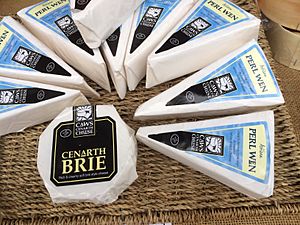
Pembrokeshire's high-quality milk also means great ice cream. Mary's Farmhouse Ices, at Crymych, has made ice cream since 1984. They use fresh fruit and local ingredients. They don't use fake flavors. Gianni's, in St Davids, makes Italian ice cream. It's made by a husband and wife team. They offer "100s of flavors." Salted caramel is a top seller. They even have ice cream for dogs!
Fire and Ice, in Narberth, uses organic milk and cream from Calon Wen and Daioni. Their chocolate and hazelnut ice creams are popular. They also make an award-winning mango sorbet that doesn't use dairy. Cowpots Ice Cream, from Whitland, is made on the farm. It comes from their special Jersey cows. Their ice cream shop is open Tuesday to Sunday. Upton Farm sells ice cream in local cafes all over the county.
Bread and Cakes
Y Felin Mill, at St Dogmaels, is very old, dating back to the 1100s. It's one of only two working mills in Wales. It's an overshot mill, meaning the water hits the top of the wheel. It makes bread and cakes. It also has the only working kiln in Wales for roasting oats. It still uses original machines from 1820. It makes organic flour and offers tours. For three generations, White's Golden Crust Bakery was in Lamphey. They made hand-made bread until Ian White passed away in 2019.
Preserves and Delicatessens
Wendy Brandon works at an old water mill called Felin Wen, in Boncath. She makes almost 200 different jams, jellies, marmalades, chutneys, vinegars, and dressings. You can see her kitchen at work, visit the shop, and taste the products.
Four Seasons, at Bethesda Cross, Saundersfoot, is a delicatessen, fruit shop, and florist. They use local produce when they can. They sell cheeses, ham, meats, and oils. Nervous Nigel makes a range of hand-made relishes, sauces, and marinades. They can be sweet or hot. You can find them in shops across Pembrokeshire.
Drinks from Pembrokeshire
Pembrokeshire has several local breweries. Bluestone Brewing Company is a family brewery in the Preseli Hills. Caffle Brewery is a microbrewery in an old school building at Llawhaden, in Cwm Gwaun. Nearby is the Gwaun Valley Brewery. It started in 2009 in an old granary near the Preseli Hills. It uses natural spring water. It also has space for events and music nights every Saturday.
Seren Brewery is another microbrewery near the Preseli Hills. It started in June 2013. This brewery won "Beer of the Festival" at the Campaign for Real Ale's (CAMRA) Pembrokeshire Beer Festival. It also won a silver medal in Dublin for its Bluestone IPA. It's in the old Syfynwy Woolen Mill, now called "The Factory." Water for the brewery comes from the reservoir at Rosebush, Pembrokeshire.
Tenby has two breweries. The Tenby Brewing Company is a microbrewery that tries to be very eco-friendly. The Tenby Harbour Brewery is in Sergeant's Lane, Tenby. This lane connects the town square to Tenby harbour. You can find this beer at the Buccaneer Inn and the Hope & Anchor Inn in Tenby. It's also in local restaurants. The Pembrokeshire Brewing Company is another local brewery.
Cwm Deri Vineyard and Estate is at Martletwy. They make country wines, liqueurs, and non-alcoholic drinks. They use fruits picked from Pembrokeshire's hedgerows, trees, and vines.
Princes Gate Spring Water is a top bottled water maker in Wales. It's on an organic farm in Narberth. The company cares deeply about the climate and the beautiful landscape where their water comes from.
Farmers' Markets in Pembrokeshire
Haverfordwest has the main county market. It's held on Saturdays. You can buy all kinds of meat, poultry, and fish that are in season. Pembroke market is also on a Saturday. Tenby has a daily market for fish.
Haverfordwest also has a farmers' market every two weeks. All the produce must come from within 40 miles of the town. It's thought to be one of the best farmers' markets in South West Wales. It's held on Fridays from 9am to 3pm at Riverside Shopping, Haverfordwest.
Pembroke holds a farmers' market on Saturday mornings in Pembroke Town Hall. Fishguard also has a farmers' market in Fishguard Town Hall. St Dogmaels Local Producers market is at the Coach House Visitor center. It's near the old abbey and watermill. It's held every Tuesday morning. You can find stalls selling fish, shellfish, cheese, cakes, preserves, eggs, and flour. St Davids Country Market is held from March to December. It offers baked goods, fresh vegetables, jams, and crafts.
Food Festivals in Pembrokeshire
Pembrokeshire has many food events. These include the Saundersfoot and St Davids Food Market. It has food and craft stalls. It's usually held around March 1st, which is St Davids Day. Haverfordwest Farmer's Market has an Easter Market and a Spring Market in May. Both have fun activities and food tasting. In June, Pembrokeshire's early potato crop is celebrated at the Pembroke Potato Festival. This is held at Pembroke Town Hall.
Pembrokeshire Fish Week is a famous, award-winning festival. It's held every June across Pembrokeshire. It has hundreds of activities about fish and fishing. You can taste seafood, learn about foraging, and take filleting classes with top chefs. There are also coastal activities like snorkel safaris, eco-fishing, and coasteering.
Haverfordwest Beer and Cider Festival is a three-day summer festival. It's held in August at Haverfordwest Castle. It focuses on cask ale. Over 20 Welsh breweries take part. You can also find Welsh craft cider and perry. Food is available, along with local music and live shows. The Pembrokeshire Agricultural Show is also in August. It's at the Withybush showground. The Frenni Food Festival at Crymych has local food, crafts, and entertainment.
In September, St Davids hosts the Really Wild Food & Countryside Festival. This weekend festival takes place at Pwll Caerog Farm. It's the only British food festival that focuses on wild food and crafts. Chefs show how to find and prepare food from hedgerows and beaches.
Narberth Food Festival is a weekend festival in September at Narberth. It brings together local producers. Chefs show how to make recipes. Live bands provide entertainment.
In December, Saundersfoot holds a Christmas Fayre. It has food, crafts, and entertainment.
Pembrokeshire Produce Mark
Pembrokeshire has its own special logo called the Pembrokeshire Produce Mark. This mark shows that a product is made in Pembrokeshire. Or, it means that a shop selling local produce displays the logo. Members of the scheme show this logo. It lets you know that the products were made in Pembrokeshire or that the shop sells local items.
Pembrokeshire Produce Direct is a group of about 70 food producers. They have their own website. They also have a central place for deliveries. This lets you buy from many producers and get one delivery. You can order weekly. Most of your order is made specially for you. They won an award for being a top online retailer in 2009/10.
Most vegetables grown in Pembrokeshire come from the Potato Marketing Group (which has a Puffin logo) and the Pembrokeshire Vegetable Growers' Association.
Pembrokeshire Recipes
Here are some original recipes from Pembrokeshire:
- Katt Pies: These are lamb and dried fruit pies. People traditionally ate them while moving livestock between Wales and London. They were sold at fairs, especially the Templeton Fair in Pembrokeshire on November 12.
- Pembrokeshire Faggots: These are savory meat patties. They are made with pig's liver, suet, breadcrumbs, and onions. They were popular in Pembrokeshire in the 1800s.
- Pembrokeshire Laverbread Cakes: These are made by pan-frying Laver bread with oats and lemon.
- Migiod: Also called yeast buns, these are traditional to Pembrokeshire. In the past, they were part of New Year celebrations. They are eaten warm and glazed with melted honey.
Traditions with St David
Eating a vegetarian diet has a long history in Pembrokeshire. It's linked to St David.
St David lived on bread, water, and herbs. Every Bishop of St David's after him followed this tradition. That is, until Bishop Morgeneu I broke it. He was killed in 999 as a result.
St David is the patron saint of Wales. He is also seen as the patron saint of vegetarians and vegans. (Though St David did eat honey!) The group "Vegetarian for Life" has made vegetarian recipes for Saint David's Day. These include Leek and Cheese Muffins, Leek Soup, Leek and Cheese Crumble, Welsh Crempog, and Bara Brith.
The leek is a symbol of St David. On Saint David's Day, the youngest member of each company in the Royal Welsh army eats a raw leek. They do this in front of everyone. Then, they make a toast (honor).
Images for kids


